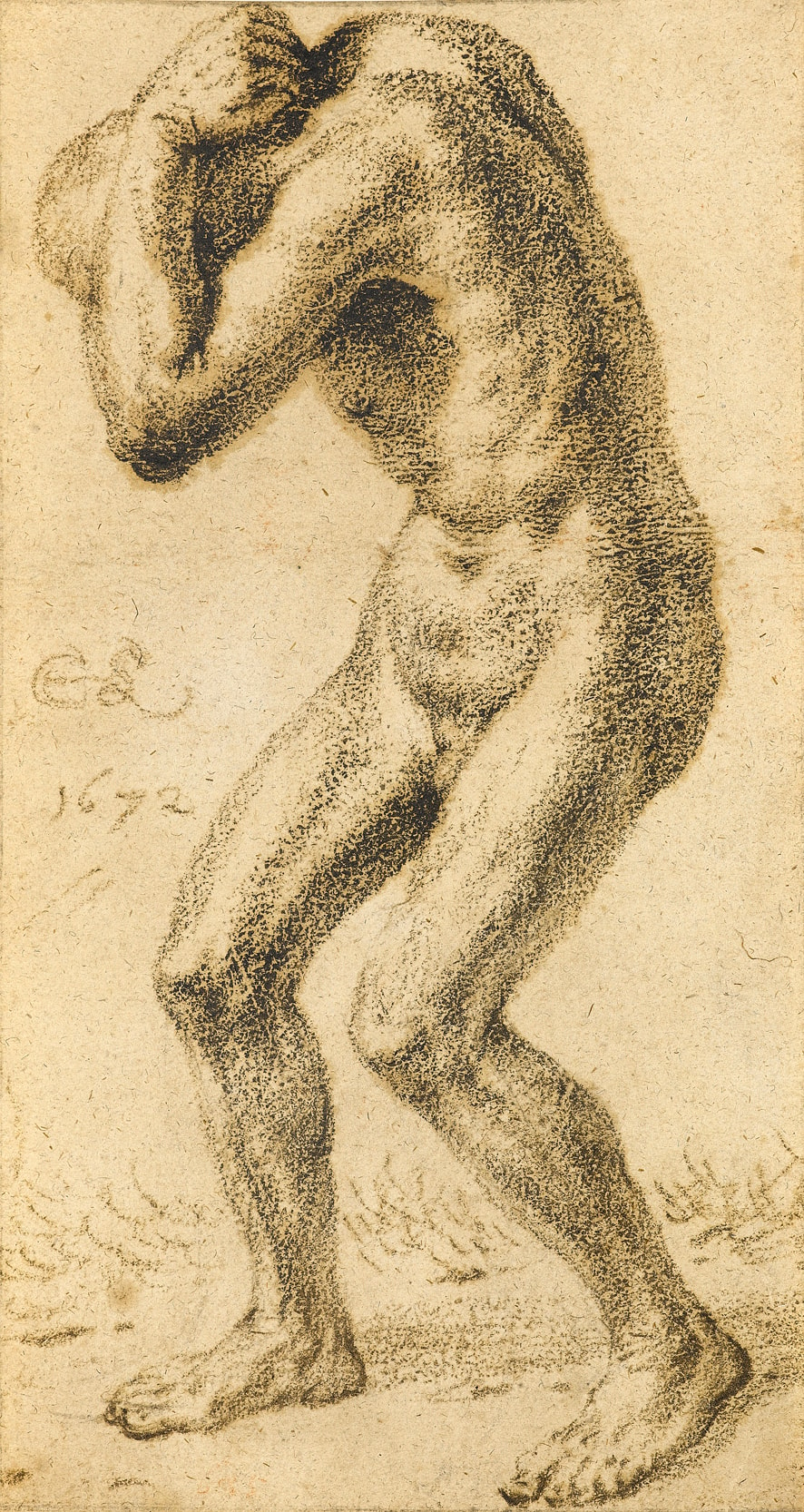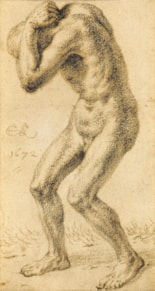Cornelius SAFTLEVEN
(Gorinchem 1607 - Rotterdam 1681)
Study of a Standing Male Nude with His Hands over his Head
Sold
Oiled black chalk on buff paper.
A study of architecture in black chalk on the verso.
Signed with the artist’s monogram and dated CS / 1672 at the left centre.
272 x 144 mm. (10 3/4 x 5 5/8 in.)
A study of architecture in black chalk on the verso.
Signed with the artist’s monogram and dated CS / 1672 at the left centre.
272 x 144 mm. (10 3/4 x 5 5/8 in.)
A prolific draughtsman, Cornelis Saftleven produced a wide variety of drawings, including a large number of single-figure studies – some of which seem to have been produced as independent works for sale to collectors - together with biblical scenes, mythological and genre subjects and landscapes, as well as numerous studies of animals. About a third of Saftleven’s drawings are signed (usually with a monogram) and dated, and examples are known for almost every year between 1625 and 1677; indeed, the number of monogrammed and dated drawings in his oeuvre would further suggest that some of these works may well have been intended to be sold.
Dated 1672, the drawing is an extremely rare example of a nude figure study in Saftleven’s extensive oeuvre as a draughtsman. Indeed, in his comprehensive catalogue of the artist’s drawings, which numbers several hundred sheets, Wolfgang Schultz lists just one drawing of a male nude; a study of a seated youth, dated 1669, in the British Museum. Like most of Saftleven’s figure drawings, the present sheet is unrelated to any known painting by the artist. David Ekserdjian hs pointed out, however, that in the pose of this figure Saftleven may have been inspired by a well-known sculptural model of a stooped figure known as Atlas; possibly to be identified with a bronze statuette of an old man attributed to Jacopo Sansovino and today in the Pushkin Museum in Moscow.
James Forbes (1749-1819) worked for the British East India Company, and lived for seventeen years in India. On Forbes’s return to England in 1784, he settled at Stanmore Hill, just to the north of London. He assembled much of his drawings and notes into the four volumes of his Oriental Memoirs, published from 1813 onwards. Forbes’s only daughter Rose married Marc-René de Montalembert (1777-1831), and their son, the journalist and historian Charles de Montalembert (1810-1870) was born in London and, after his father’s return to Paris, was raised by James Forbes at Stanmore Hill.
Dated 1672, the drawing is an extremely rare example of a nude figure study in Saftleven’s extensive oeuvre as a draughtsman. Indeed, in his comprehensive catalogue of the artist’s drawings, which numbers several hundred sheets, Wolfgang Schultz lists just one drawing of a male nude; a study of a seated youth, dated 1669, in the British Museum. Like most of Saftleven’s figure drawings, the present sheet is unrelated to any known painting by the artist. David Ekserdjian hs pointed out, however, that in the pose of this figure Saftleven may have been inspired by a well-known sculptural model of a stooped figure known as Atlas; possibly to be identified with a bronze statuette of an old man attributed to Jacopo Sansovino and today in the Pushkin Museum in Moscow.
James Forbes (1749-1819) worked for the British East India Company, and lived for seventeen years in India. On Forbes’s return to England in 1784, he settled at Stanmore Hill, just to the north of London. He assembled much of his drawings and notes into the four volumes of his Oriental Memoirs, published from 1813 onwards. Forbes’s only daughter Rose married Marc-René de Montalembert (1777-1831), and their son, the journalist and historian Charles de Montalembert (1810-1870) was born in London and, after his father’s return to Paris, was raised by James Forbes at Stanmore Hill.
The elder brother of the landscape painter Herman Saftleven, who remains much better known today, Cornelis Saftleven spent most of his career in Rotterdam. He is thought to have received his training there, alongside his brother, in the studio of their father, a history painter. A versatile and imaginative artist, with a predilection for unusual and inventive subjects, Cornelis Saftleven painted landscapes, peasant genre scenes (often of a satirical nature), barn interiors and still life subjects, religious and allegorical scenes, as well as the occasional portrait and a number of phantasmagorical subjects and diableries. (That he was particularly regarded for his paintings of fantastic subjects is seen in the caption accompanying the reproduction of his portrait by Anthony Van Dyck, included in the series of famous prints of artist’s portraits known as the Iconography, in which he is described as ‘Hollandus Pictor Notium Phantasmatum’.) Saftleven became dean of the painter’s guild in Rotterdam in 1667. Around two hundred paintings by the artist are known or recorded, many dated between 1629 and 1678.
Provenance
Probably James Forbes, Stanmore Hill, Middlesex
By descent to his grandson Charles Forbes René de Montalembert, Comte de Montalembert, Paris
Thence by descent until 2013.
Literature
David Mandrella et al, La pointe et l’ombre: Dessins nordiques du musée de Grenoble XVIe–XVIIIe siècle, exhibition catalogue, Grenoble, 2014, p.182, note 4, under no.86 (entry by David Mandrella); Heiko Damm and Henning Hoesch, ed., galleria portatile: Old Master Drawings from the Hoesch Collection, Petersberg, 2017, pp.290-293, no.70 (entry by Henning Hoesch).




